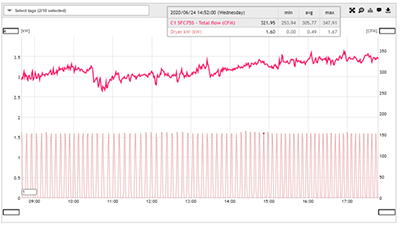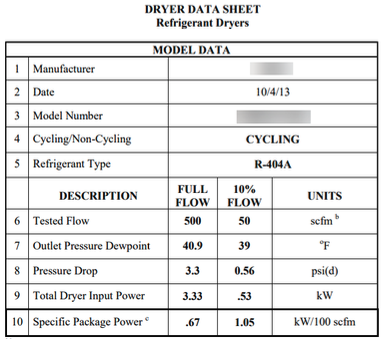
Running your home refrigerator like a non-cycling air dryer would run up your electrical bill considerably. The non-cycling style dryer consumes almost constant power, as if the dryer was fully loaded, even in conditions of part load and partial moisture content.
Temperature control is accomplished in these types of dryers with a hot gas bypass valve that keeps the evaporator above the freezing point of water by bypassing refrigerant around the cooler, but keeping the refrigerant compressor loaded at full power. If your refrigerator worked like this, it would be running constantly, even when the setpoint temperature was satisfied.
Cycling dryers work like a home refrigerator, turning the refrigerant compressor on and off on a temperature switch, or controlling it in such a way (with VSD or special compressor) that the power consumption turns down in proportion to the flow of air and the moisture content of the compressed air to be processed. This saves energy.

A printing plant is a recent example of success in selecting a good cycling style dryer (all dryers are not alike). This cycling dryer was found during a recent compressed air audit to be consuming only 30% of its nameplate power consumption in its average conditions of operation. The dryer, rated at 520 cfm, was matched up with a compressor rated at 440 cfm. Average loading was 300 cfm and the inlet temperature of the air was well below the 100° F rating of the dryer. Air flow was about 60% of the dryer rating, but the moisture load — because water content reduces by half for every 20° F in lower inlet temperature — was less than 30% of the dryer rating.
Because a larger sized dryer was chosen, this system has the capability of making rated dewpoint even in very hot and humid worst-case conditions. And due to the larger size compared to the compressor rating, the pressure loss across the dryer and the associated mist eliminator filter averages only 1.5 psi compared to a typical 5 psi.
This reduced discharge pressure, and lower dryer power consumption, has saved this plant about $20,000 power costs, over the 10-year life of the dryer, more than double its purchase price!!
Be sure to check out the CAGI data sheets of any refrigerated dryer you intend to purchase, these will tell you the performance of the dryer at full and partial load. The goal is to choose a dryer with a large power turn down.
Dryer savings are only a small part of what can be gained in optimizing systems, but every little bit counts.

Leave a Reply